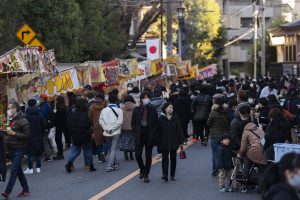In Japan, the first alarm over COVID-19 was sounded in early February 2020 with cases detected onboard the Diamond Princess cruise ship docked in the port city of Yokohama, which neighbors Tokyo. Ten months down the line, Tokyo has been placed on the highest coronavirus warning alert as authorities struggle to contain the explosive spread of COVID-19, which is shattering daily records.
On New Year’s Eve, Tokyo recorded its highest number of coronavirus infections in a single day, with 1,337 cases. That marked the first time daily positive cases in Tokyo exceeded 1,000, following the previous high of 949 reported infections on December 26. Tokyo recorded 944 daily cases on December 30 and 783 on January 1.
Tokyo Governor Koike Yuriko warned that a state of emergency would be declared if the unprecedented number of cases was not brought under control. In her last press conference of 2020, Koike said the capital was under attack by a third wave of COVID-19 and warned that severe unknown challenges await in the new year. She urged residents against end-of-year parties and requested that families stay at home. Tokyo faces a watershed moment in terms of crisis management, Koike said. She stressed that “it’s no exaggeration that the actions of each one of us will determine the start of the new year.”
The end of year and New Year holidays in Japan are traditionally celebrated by returning to one’s hometown to spend quiet time with immediate family and grandparents. But the minister in charge of economic revitalization, Nishimura Yasutoshi, urged people to refrain from heading back home, and if travel was unavoidable he suggested greeting family members from the front door.
In Japan, coronavirus fatigue and complacency is rife among young people. Contrary to Koike’s calls to avoid celebrating the New Year’s Eve countdown, images taken in the youth and entertainment districts of Shibuya in Tokyo showed large crowds gathering in packed numbers, despite the official event being cancelled.
Last week among Japan’s 5,007 confirmed COVID-19 cases, the highest percentage came from people in their 20s at 26.7 percent, followed by 20.3 percent for people in their 30s and 15.9 percent for people in their 40s. Tracing the route of infections to detect clusters is proving difficult with 70 percent of positive cases unable to identify where they may have caught the virus.
At a COVID-19 monitoring meeting in Tokyo, experts pointed out that the seven-day average of new positive cases was increasing for the third week in a row. Experts predict the rapidly increasing rate of new positive tests means that critically ill patients will outnumber the 4,000 secured beds within two weeks. The surge in coronavirus cases also threatens Japan’s medical system, which is in a critical phase. The number of hospitalized patients reached 2,274 as of December 29 with the number of people receiving medical treatment at home reaching 2,768. Prevention is key to keeping these numbers in check, and experts argue stronger control measures are needed immediately for at least three weeks before the number of infections can slow down.
A shortage of frontline medical staff during the pandemic has been exacerbated by poor working conditions, crippling overtime, abuse from colleagues, and discrimination experienced from neighbors. A shortfall of revenue facing health facilities nationwide has resulted in pay cuts and slashed summer bonuses as COVID-19 patients clog medical facilities and slash the numbers of patients in surgery, maternity and cancer wards amid nurse shortages. In mid-December a coronavirus-designated hospital in Osaka received a desperately needed boost from the Japanese Self-Defense Force medical corps after struggling to run its daily operations and hire new nurses. A number of medical staff had walked out of the hospital since June.
Moreover, many hospitals across Japan were found to have miscalculated the expected maximum number of inpatient hospitalizations during the third wave. Local hospitals and health facilities are assigned a certain percentage of the population and the estimates for COVID-19 hospitalizations were found to be as low as 12 in areas such as the densely populated commercial hub of Shinjuku in Tokyo, which has recorded as many as 50 to 100 positive daily infections. With infections spreading rapidly in autumn, unrealistic assumptions based on data from the first wave has contributed to delays in securing beds for coronavirus patients and boosting the efficiency of health centers.
Japan has also detected new cases of the U.K. coronavirus mutation, which is said to be up to 70 percent more infectious. The new mutation on top of Japan’s current explosion of cases adds fear that the worst is yet to come.

































